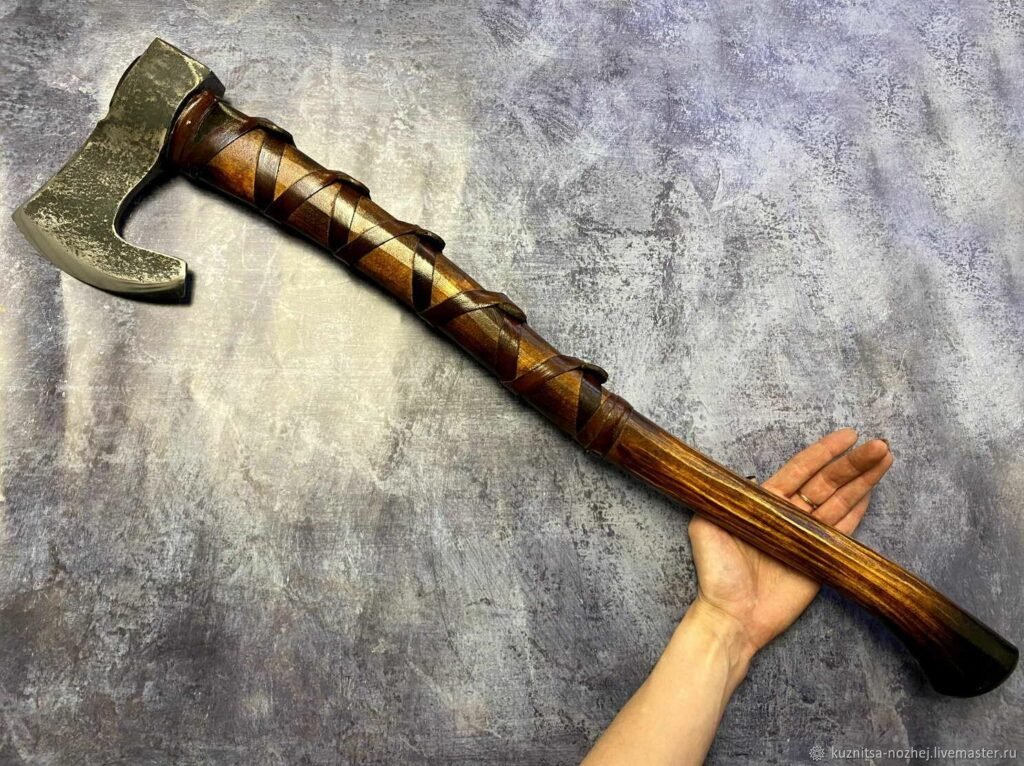When we think of the Vikings, images of fierce warriors wielding axes often come to mind. But what was it that made the Viking axe such an effective weapon in battle? In this article, we’ll dive into the design, versatility, and cultural significance of the Viking axe that made it not just a tool but a formidable weapon on the battlefield.
Introduction
The Importance of the Viking Axe in Warfare
The Viking axe was more than just a tool for chopping wood; it was a vital instrument of war that played a crucial role in Viking raids and battles. Its effectiveness stemmed from a combination of design, functionality, and the warrior’s skill in wielding it.
Historical Context
To fully understand the significance of the Viking axe, we need to consider the historical backdrop in which it thrived.
The Role of the Axe in Viking Society
In Viking society, axes were commonly used by both warriors and everyday people. They served practical purposes, from farming to woodworking, but they were also readily accessible weapons. This dual-purpose nature made the axe a staple in every Viking household.
Comparison with Other Weapons
While swords were often viewed as the elite weapons of war, axes were more widely used. They were easier to produce, more affordable, and deadly effective. In many cases, a well-crafted axe could do everything a sword could do and more, especially in the hands of a skilled fighter.
Design Features of the Viking Axe
One of the most critical factors contributing to the axe’s effectiveness was its design.
Blade Shape and Size
The blade of a Viking axe was typically broad and heavy, allowing for powerful strikes. The design varied, but most axes featured a curved edge that could slice through armor and shields with ease. This shape provided a balance between weight and maneuverability, making it easier to deliver devastating blows.
Handle Length and Material
The length of the axe handle also played a significant role in its effectiveness. Most Viking axes had long handles, enabling two-handed use, which added leverage and power to strikes. The materials used for the handles were often hardwoods, which provided strength and durability.
Bearded Design: Functionality and Aesthetics
Many Viking axes featured a “bearded” design, where the lower part of the blade extended downwards. This unique shape allowed for better control and precision, making it easier to hook and disarm opponents during combat. Plus, the bearded design added an aesthetic appeal, showcasing the craftsmanship involved in axe-making.
Versatility of the Viking Axe
The Viking axe wasn’t just a weapon; it was a versatile tool that could be used in various scenarios.
Combat Applications
In battle, the Viking axe was used for both offense and defense. Warriors could swing it to deliver crushing blows or use the pointed end for stabbing. This versatility made it effective against both armored opponents and in close-quarters fighting.
Dual-Use as a Tool and Weapon
Beyond combat, the axe served everyday functions, such as chopping wood or building shelters. This dual-use made it a practical choice for Viking warriors, who often needed to rely on their weapons for survival in harsh environments.
Skill and Training
Viking Warrior Training
To effectively wield an axe in battle, Viking warriors underwent rigorous training. They practiced not only with the axe but also with various weapons, enhancing their combat skills and techniques.
Importance of Technique
The effectiveness of the Viking axe wasn’t just about brute strength. Proper technique was essential. Warriors learned how to use their body weight to generate power behind their swings, ensuring that each blow was as effective as possible.
Psychological Factors in Battle
The Fear Factor
The Viking axe also held psychological power. The mere sight of a warrior wielding a massive axe could instill fear in opponents. This psychological edge often gave Vikings an advantage before the battle even began.
Status Symbol in Viking Culture
In addition to its combat effectiveness, the axe was a symbol of status and prowess. A beautifully crafted axe could signify a warrior’s rank and achievements, enhancing their reputation on and off the battlefield.
Battle Tactics Involving the Axe
Understanding how the axe was used in battle is crucial to appreciating its effectiveness.
Formation and Group Tactics
Vikings often fought in close formation, using their axes in coordinated attacks. The weight and power of the axe complemented their tactics, allowing them to deliver devastating blows to their enemies in unison.
Individual Combat Techniques
In one-on-one combat, skilled Viking warriors used their axes to exploit their opponents’ weaknesses. They would often aim for joints in armor or target vital areas, showcasing the deadly precision that the Viking axe allowed.
Cultural Significance of the Axe
The Viking axe wasn’t just a tool of war; it was steeped in cultural significance.
The Axe in Norse Mythology
Axes feature prominently in Norse mythology, often associated with gods and heroes. This cultural backdrop further enhanced the axe’s status as a powerful weapon, woven into the very fabric of Viking identity.
Symbol of Power and Leadership
Leaders in Viking society often carried elaborately crafted axes as symbols of power and authority. A well-made axe could command respect and serve as a rallying point for warriors in battle.
Maintenance and Craftsmanship
The craftsmanship involved in making Viking axes also contributed to their effectiveness.
Quality of Materials Used
Skilled blacksmiths crafted Viking axes from high-quality steel, ensuring their strength and durability. The craftsmanship was vital in producing axes that could withstand the rigors of battle.
The Role of Blacksmiths
Blacksmiths held a prestigious place in Viking society. Their expertise in forging weapons meant that warriors could rely on high-quality equipment, further enhancing their effectiveness in battle.
Conclusion
The Viking axe’s effectiveness in battle was a product of thoughtful design, versatility, and cultural significance. From its lethal blade to its dual-use functionality, the axe was a weapon that embodied the spirit of the Viking warrior. Understanding what made the Viking axe so effective not only highlights the ingenuity of Viking craftsmanship but also gives us a glimpse into the fierce and dynamic world of Viking warfare.
FAQs
Were Viking axes used for anything other than battle?
Absolutely! Viking axes were versatile tools used for chopping wood, farming, and other everyday tasks.
How did the Viking axe compare to swords?
While swords were often considered elite weapons, axes were more widely used due to their availability, cost-effectiveness, and combat versatility.
What types of axes did the Vikings use?
Vikings used various axes, including the bearded axe, Dane axe, and throwing axes, each serving different purposes in battle and daily life.
Did all Vikings use axes?
Not all Vikings used axes, but they were common among warriors. Many also used swords, spears, and other weapons depending on personal preference and availability.
How were Viking axes made?
Viking axes were crafted by skilled blacksmiths using high-quality steel and wood, often featuring unique designs that reflected the owner’s status and achievements.



More Stories
Industrial Revolution 4.0 and the Dawn of Industry 5.0
Why Choose Dubai for Your Business? A Guide to Top Business Setup Consultants and Solutions Providers
Durable Custom wax Paper: Keeps Food Fresh